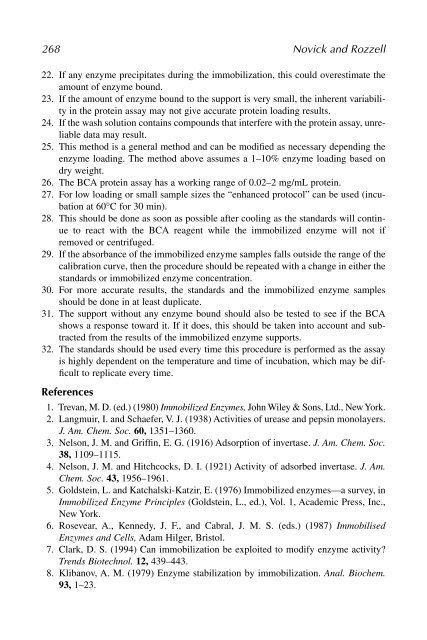Microbial Enzymes and Biotransformations Microbial Enzymes and ...
Microbial Enzymes and Biotransformations Microbial Enzymes and ...
Microbial Enzymes and Biotransformations Microbial Enzymes and ...
Create successful ePaper yourself
Turn your PDF publications into a flip-book with our unique Google optimized e-Paper software.
268 Novick <strong>and</strong> Rozzell<br />
22. If any enzyme precipitates during the immobilization, this could overestimate the<br />
amount of enzyme bound.<br />
23. If the amount of enzyme bound to the support is very small, the inherent variability<br />
in the protein assay may not give accurate protein loading results.<br />
24. If the wash solution contains compounds that interfere with the protein assay, unreliable<br />
data may result.<br />
25. This method is a general method <strong>and</strong> can be modified as necessary depending the<br />
enzyme loading. The method above assumes a 1–10% enzyme loading based on<br />
dry weight.<br />
26. The BCA protein assay has a working range of 0.02–2 mg/mL protein.<br />
27. For low loading or small sample sizes the “enhanced protocol” can be used (incubation<br />
at 60°C for 30 min).<br />
28. This should be done as soon as possible after cooling as the st<strong>and</strong>ards will continue<br />
to react with the BCA reagent while the immobilized enzyme will not if<br />
removed or centrifuged.<br />
29. If the absorbance of the immobilized enzyme samples falls outside the range of the<br />
calibration curve, then the procedure should be repeated with a change in either the<br />
st<strong>and</strong>ards or immobilized enzyme concentration.<br />
30. For more accurate results, the st<strong>and</strong>ards <strong>and</strong> the immobilized enzyme samples<br />
should be done in at least duplicate.<br />
31. The support without any enzyme bound should also be tested to see if the BCA<br />
shows a response toward it. If it does, this should be taken into account <strong>and</strong> subtracted<br />
from the results of the immobilized enzyme supports.<br />
32. The st<strong>and</strong>ards should be used every time this procedure is performed as the assay<br />
is highly dependent on the temperature <strong>and</strong> time of incubation, which may be difficult<br />
to replicate every time.<br />
References<br />
1. Trevan, M. D. (ed.) (1980) Immobilized <strong>Enzymes</strong>, John Wiley & Sons, Ltd., New York.<br />
2. Langmuir, I. <strong>and</strong> Schaefer, V. J. (1938) Activities of urease <strong>and</strong> pepsin monolayers.<br />
J. Am. Chem. Soc. 60, 1351–1360.<br />
3. Nelson, J. M. <strong>and</strong> Griffin, E. G. (1916) Adsorption of invertase. J. Am. Chem. Soc.<br />
38, 1109–1115.<br />
4. Nelson, J. M. <strong>and</strong> Hitchcocks, D. I. (1921) Activity of adsorbed invertase. J. Am.<br />
Chem. Soc. 43, 1956–1961.<br />
5. Goldstein, L. <strong>and</strong> Katchalski-Katzir, E. (1976) Immobilized enzymes—a survey, in<br />
Immobilized Enzyme Principles (Goldstein, L., ed.), Vol. 1, Academic Press, Inc.,<br />
New York.<br />
6. Rosevear, A., Kennedy, J. F., <strong>and</strong> Cabral, J. M. S. (eds.) (1987) Immobilised<br />
<strong>Enzymes</strong> <strong>and</strong> Cells, Adam Hilger, Bristol.<br />
7. Clark, D. S. (1994) Can immobilization be exploited to modify enzyme activity?<br />
Trends Biotechnol. 12, 439–443.<br />
8. Klibanov, A. M. (1979) Enzyme stabilization by immobilization. Anal. Biochem.<br />
93, 1–23.

















